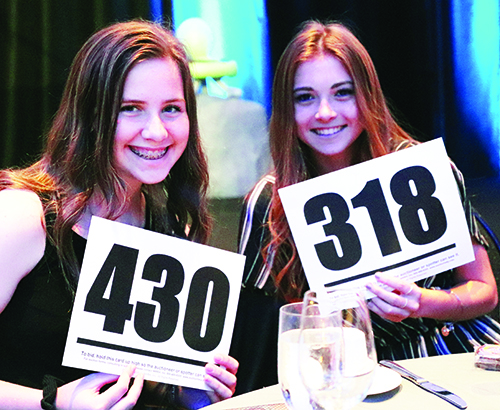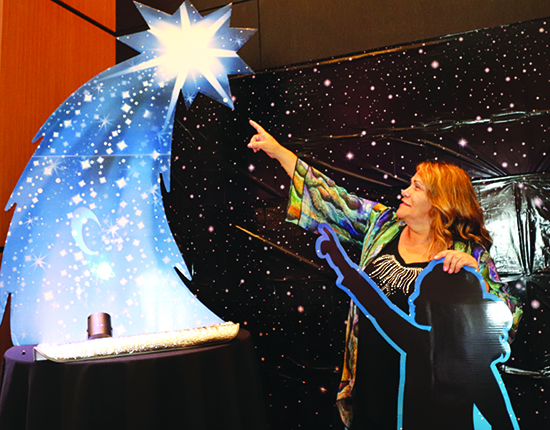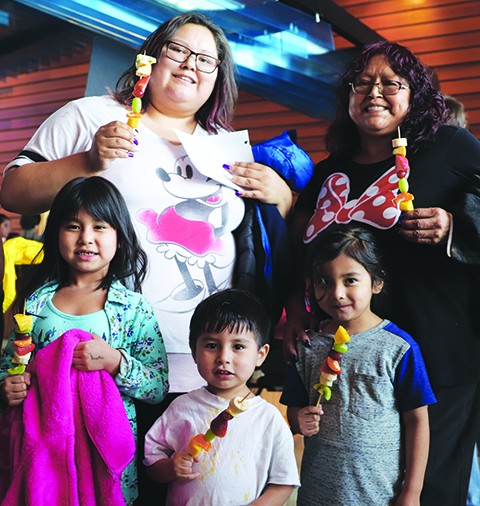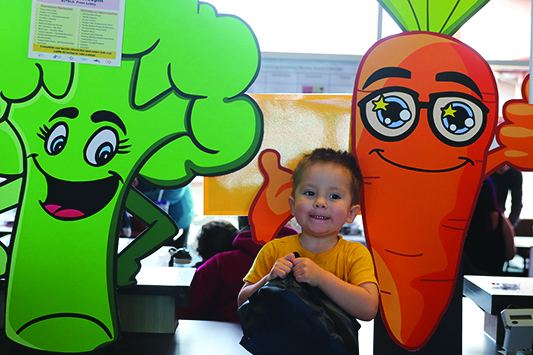Please use the following link to download the April 6, 2019 issue of the syəcəb: SYS 04062019
syəcəb
Permit sales will be on 4/26/2019 and 5/3/2019 at the Tulalip Tribes Administration Building
Sales will be from 12:00 PM to 4:30 PM each day.
Payments are acceptable in the form of cashier check or money order. NO CASH PAYMENTS ARE ACCEPTED!
Boom City Committee Contact Information
By Kalvin Valdillez, Tulalip News; photos courtesy of Tulalip Bay Fire Department
The aroma of delicious breakfast wafted through the Tulalip Bay Fire Department early on the morning of March 23. Catering trays filled with bacon and sausage were stationed inside of the firehouse garage while local firefighters whipped up scrambled eggs and flipped pancakes on large flat griddles. Families lined up and were served a freshly prepared meal while visiting with the fire crew and touring the station at the second annual Leroy Fryberg Sr. Pancake Breakfast.
“The fire station itself is named after Leroy because of his commitment to our area and to the department. We wouldn’t be where we are today if it wasn’t for him,” says Tulalip Bay Firefighter, Patrick Dineen. “If you look back throughout the history of the department, he was involved in every step. Our intent for the pancake feed is not only to open the house up to the tribal and non-tribal members who live in the area, but to also shed light on the fact that he gave thirty years of his life to our department.”
According to multiple family members and many members of the fire district, Leroy was integral in progressing the department forward and helping to find funding, as well as volunteering at the station and serving as a commissioner. Leroy’s presence helped connect the fire department with the community as they recognized a friendly face and found comfort in knowing Leroy and his team would do everything and anything they could to help, while they were in dire need. Having the people’s trust is important for any fire department, especially when in stressful situations, and for this reason Tulalip Bay continues the work Leroy started by participating and hosting a number of community-based events.
“As a fire department, we show up on people’s worst days and try our best to help and solve any problems,” explains Dineen. “Most of the time, I’d say 99% of the time, it’s a good interaction and we get out there and do our jobs, but sometimes there are things that are out of our control. Building good community rapport is huge for fire departments. To have the community show up at our house and participate in this event is important. When residents in our area are in need of our assistance, we want to be able to show up and say hello. We want to know people before we show up and also have the people know who we are. We don’t want to be strangers, we want to be a part of the community, just as their neighbors. This event and other events that we participate in really help with that.”
Outside of the department, kids and elders alike waited patiently in line for a chance to have a blast, literally, by spraying large amounts of water across the driveway of the fire station through a firehose. This year, the fire department made the celebration all the more special by involving the Fryberg family, who happily participated by setting up a face painting booth for the kids. And to cap off the exciting morning, attendees were paid a surprise visit from Sparky the Fire Dog, the National Fire Protection Association mascot.
Leroy’s legacy has inspired a new generation of tribal firefighters and commissioners. By honoring his work and hosting an event in his remembrance, his passion and efforts will live on within the department for years to come.
“This is only our second year and we had about 400 to 500 people show up,” Dineen states. “It was a really good turnout. We were busy serving breakfast the entire time, in fact, at one point, we even ran out of pancake batter. We want to see this continue to build, to where it becomes a popular event that everyone puts on their calendar months before it happens. It’s a great way for us to honor Leroy and also a great way for the people to come and have some breakfast with us. We want to thank all the families who came out and we are definitely looking forward to next year!”

By Micheal Rios, Tulalip News
The 27th annual Chocolate Lovers’ Gala was a sellout event attracting 550 thoughtful attendees to generously give from the heart and wallets to make a difference in the lives of domestic violence victims, survivors and their families. Benefiting Domestic Violence Services (DVS) of Snohomish County, the annual gala transformed the Tulalip Resort Casino’s Orca Ballroom into an out of this world experience with the theme “To Peace and Beyond!”
“It’s our number one event of the year,” said DVS Executive Director Vicci Hilty of the high-energy gala and accompanying auctions. “Last year was the first time we raised over $200,000 and from the way it feels tonight I think we’re going to top it once again. These dollars we raise are the most important ones because they literally keep the lights on. Money raised helps every client we have and funds all the services we provide to help anyone who’s been abused and are a victim of domestic violence.
“Having Tulalip’s Charitable Contributions Fund be this year’s title sponsor means so very much,” continued Vicci. “To have a community partner that understands what it’s like to be in these situations is absolutely paramount. The Tribe is such an important partner for us and are a critical piece for everything we do every day as an organization.”

There was a variety of eye catching space-themed props and backdrops perfect for photo opportunities, along with a seemingly limitless supply of flavorful wine and decadent chocolate keeping the atmosphere fun and upbeat on the evening of March 29. The popular gala also featured a silent auction with hundreds of items ranging from a Russell Wilson signed football to handmade quilts and jewelry to limited edition bottles of Cabernet Sauvignon.
During the live auction, 35 big-ticket items, including several destination vacation packages and international cruises, resulted in exciting bidding wars with all proceeds benefitting the DVS. The local nonprofit has served Snohomish County since 1976 and provides comprehensive, confidential services to all victims of domestic abuse. Services include a 50+ bed emergency shelter, 24-hour hotline, supportive housing, support groups, legal advocacy, children’s programs, and community education.
Switching tones from lighthearted to serious, a video montage of domestic violence survivors played on several large Orca Ballroom projector screens. Courageous stories were shared followed by podium speakers giving voice to victims who all too often suffer in silence.
“Think about this: if someone’s father has Alzheimer’s then we rally around them. If someone’s mother has cancer or someone’s kids are sick then we donate our vacation time, we cover there shifts at work,” shared guest speaker Dr. Robin Fenn of Verdant Health. “For these individuals we bring them home cooked meals and send texts saying ‘thinking of you’ or ‘hope everything is okay’. But with domestic violence we avert our eyes, we whisper at the water cooler, and we don’t ask questions.
“Isolation is one of the biggest contributors to domestic abuse. If you see something, then say something. Please have the courage and grace to make eye contact and ask the hard questions. And if you have the stories be brave enough to share them because if we don’t give voice to this, then who will?”
Domestic violence affects millions of people in the U.S. every year. All divisions of society are impacted regardless of age, race, religion, sexual orientation or socioeconomic status. The National Intimate Partner and Sexual Violence survey found that every minute, 20 people in the U.S. are victims of physical violence by an intimate partner. One in three women and one in ten men, or 45 million adults, experience physical violence, rape, and/or stalking by an intimate partner during their lives.*
A victim’s life may be in most danger when they attempt to leave or seek a protection order against their abusers. Which is why organizations like DVS of Snohomish County are dedicated to ending domestic abuse by providing a wide range of services to victims and by facilitating social change. The agency believes every individual has the right to live in a safe, nurturing environment.
“Our partnership with Domestic Violence Services is extremely important to take care of our people,” shared soon-to-be Tulalip Tribes Chairwoman Teri Gobin. “In the past, people stayed in abusive relationships because they had no safe place to go. If there were kids then they suffered watching the abuse happen and often got abused themselves. It’s another historical trauma that’s happened to our people.
“I’m excited for our DVS partnership because it makes more options available for our people, and our current programs utilize these resources to help those in need of assistance,” added Teri.
The 27th annual Chocolate Lovers’ Gala was a huge success because of the community, business partners, and generous individuals who collectively contributed a record breaking $276,000. All funds raised support the services needed to stop domestic violence, and the fear it brings into the lives of countless victims and their precious children.
If you or someone you know is a victim of domestic violence, Domestic Violence Services of Snohomish County can help you. For information, please call their 24-hour crisis hotline: 425-25-ABUSE (425-252-2873).
*Source: 2016 Biennial Report to Congress, D.O.J. Office on Violence Against Women
Submitted by Ryan Miller, Environmental Liaison, Tulalip Tribes Natural Resources
ON THE TREATY FRONT: A series on the history and meaning of tribal sovereignty, treaty rights, environmental stewardship and issues that threaten these important rights. This is the second in a recurring series of articles produced by the Tulalip Tribes Treaty Rights Office to help educate and inform the membership. Our Mission is to “Protect, enhance, restore and ensure access to the natural resources necessary for Tulalip Tribal Members’ long-term exercise of our treaty-reserved rights.”
Indian Law: Understanding Treaty Fishing Rights
In treaties signed with the U.S. Government, our ancestors made great sacrifices by ceding millions of acres of land to the federal government in exchange for certain protections for our traditional and cultural values and ways of life. Article Five of the Treaty of Point Elliott guarantees the signatory tribes the right of taking fish at their usual and accustomed grounds and stations in common with all citizens as well as hunting and gathering roots and berries on open and unclaimed lands. Despite the federal government’s guarantees to tribes that they would be able to take fish as they always have, throughout the first half of the 20th century Indian fishermen faced fierce opposition to exercising this right from the State of Washington and non-Indian fisherman. These tensions led to battles in court, all of which contributed to the decision made by Judge George Boldt in US v Washington also known as “The Boldt Decision”, the foundational Indian treaty fishing rights case.
In 1905, the United States Supreme Court handed down the first decision addressing treaty fishing rights in U.S. v. Winans. In that case, the United States brought suit on behalf of the Yakima Nation against the Winans Brothers who, by attaining a permit for a fish wheel from the State of Washington had not only depleted the Yakimas’ fish supply but had also prevented them from accessing their traditional fishing grounds. The Supreme Court’s decision laid the foundation for the interpretation of treaties in the future and produced what was later called the “cannons of treaty interpretation”.
We have said we will construe a treaty with the Indians as “that unlettered people” understood it, and “as justice and reason demand, in all cases where the power is exerted by the strong over those to whom they owe care and protection”, and counterpoise the inequality “by the superior justice which looks only to the substance of the right, without regard to technical rules.”
The Supreme Court in US v Winans held that treaties are “not a grant of rights to the Indians, but a grant of rights from them and a reservation of those not granted”. The Supreme Court’s ruling states that issues of treaty interpretations must favor Indians as they were at a severe disadvantage during the negotiations which took place in a foreign language and often with the threat of violence. The court also notes that treaties must be interpreted the way the Indians of the time would have understood them. This idea is critical because our ancestors were deeply concerned about having access to all the places that they had always gathered and their concerns were heard by Governor Stevens who reassured them that they would always have access to their traditional places and resources.
I wish to speak my mind as to selling the land. Great chief! What shall we eat if we do so? Our only food is berries, deer, and salmon. Where then shall we find these? I don’t want to sign away my right to the land…..I am afraid that I shall become destitute and perish for want of food.
Hool-hol-tan, Skokomish leader speaking to Gov. Isaac Stevens at treaty negotiations 1855 (from article in Pacific Northwest Quarterly)
Governor Stevens responded to questions like these at all of the treaty negotiations,
You understand well my purpose, now you want to know what we desire to do for you. We want to give you houses and having homes you will have the means and the opportunity to cultivate the soil to get your potatoes and to go over these waters in your canoes to get your fish. We want more, if you desire to go back to the mountains and get your roots and your berries you can do so and you shall have homes and shall have these rights.
The courts determined that though the Winans Brothers acted lawfully by the standards of the State of Washington; they had violated the Yakima Nation’s treaty rights by restricting their access to traditional fishing grounds.
In 1942 Sampson Tulee, a member of the Yakima Nation, was convicted in the Superior Court of Klickitat County for catching salmon with a net without obtaining a license from the State of Washington. Tulee appealed to the Supreme Court on the grounds that the Washington State statute violated his treaty right. The court, in Tulee v. Washington, held that while the State of Washington had the right to regulate Treaty fishing outside the reservation for the conservation of species, it could not charge a fee to Indians for the license required.
We believe that such exaction of fees as a prerequisite to the enjoyment of fishing in the ‘usual and accustomed places’ cannot be reconciled with a fair construction of the treaty. We therefore hold the state statute invalid as applied in this case…It is our responsibility to see that the terms of the treaty are carried out, so far as possible, in accordance with the meaning they were understood to have by the tribal representatives at the council and in a [315 U.S. 681, 685] spirit which generously recognizes the full obligation of this nation to protect the interests of a dependent people.
While these cases represent “wins” for treaty tribes and their members they are also directly reflected in the decision of Judge Boldt in US v Washington. Over 100 years after the signing of the treaty and years of conflicts over treaty fishing, the U.S. sued the state of Washington in 1970 on behalf of Washington’s treaty tribes.
Stay tuned for our next article which will focus on the landmark Indian Law case US v Washington and other treaty fishing decisions all the way through to the culvert case.
By Micheal Rios, Tulalip News
School groups visit Hibulb Cultural Center (HCC) frequently to receive an educational tour of the 23,000 square foot facility dedicated to collecting and enhancing the traditional cultural values and history of the Tulalip Tribes. These school group tours always start in the HCC longhouse with a brief video presentation that introduces the legacy of the Tulalip people to students with minimal knowledge of Native peoples in general, let alone specific knowledge about the successors in interest to Snohomish, Snoqualmie and other tribes signatory to the Treaty of Point Elliot.
However, once a year when then the 3rd graders from Quil Ceda Tulalip (QCT) Elementary have their school tour the script is a bit different. These particular 3rd graders do have knowledge, an inherent history, and personal experiences galore with what it means to be a Native American citizen and Tulalip culture bearers. For Quil Ceda 3rd graders, their museum tour is less new information acquisition and more reinforcement of a history they breathe life into every day.
“We have a partnership with Marysville School District and the Indigenous Education Department to bring in every single 3rd grade class within the district and give them a museum a tour,” explains Mary Jane Topash, HCC Group Tour Specialist. “The Quil Ceda tours are unique because for a lot of the students it’s their own family history being exhibited, which means my tours with them are different. I can play off their background knowledge and personal histories they have as tribal members and growing up Tulalip.
“During the Quil Ceda tours we really reinforce key values and history points that make us Tulalip,” continued Mary Jane. “There were several students that went to the family tree section and entered their own tribal IDs to find their family connections within the Hibulb exhibits. That is something unique only they are able to connect with.”
From teachings of the cedar tree to lifeways of salmon, HCC exhibits echo traditional values many of the QCT students have heard and experienced many times over during their young lives. Of course that doesn’t mean they no longer get super excited to showcase their natural skills with a cedar weave, yarn pattern, or fish net…because they certainly do.
Young tribal members were seen routinely schooling their non-Native counterparts on what certain exhibits were really about. In some exhibits there is an option to hear narration in either English or traditional Lushootseed. Many of the kids didn’t hesitate to choose Lushootseed, making their teachers very proud.
While learning from the wool exhibit, the kids were hyped when they saw the puppet theater setup. Many took the opportunity to use their imagination and do creative storytelling all on their own with the puppets available. Also in the wool exhibit is a digital touch-screen game that teaches weaving basics in a comfortable setting today’s children are most used to. The interactive nature of such exhibits made learning all the more easier, while still holding the rambunctious groups attention.
“With many of the Quil Ceda third graders being Tulalip tribal members, we stressed the important and significance of our lifeways while exploring our canoes, cedar collection and life cycle of salmon exhibits,” shared museum assistant Cary Michael Williams. “We got into our 1855 treaty and explaining its importance to our everyday life today, and how our treaty rights allows us to live our culture.
“It was a very good opportunity to share more insight on what that means to them and their responsibility as tribal members to uphold those rights for future generations. It was an honor to see our young people interact with Hibulb and make connections they can take with them going forward while bringing cultural values into their own lives.”
The foundation of their Quil Ceda education allowed the four 3rd grade classes to use Hibulb educational spaces in an engaged and interactive way. Drawing from their own experiences and family history, students demonstrated traditional skills like fish net tying and cedar weaving, while practicing Lushootseed words to connect with various exhibits. Witnessing them interact with exhibits and cultural items with an innate understanding that required zero explanation is proof the next generation of culture bearers will have much to add to Tulalip’s history of resiliency and self-determination.
By Kalvin Valdillez, Tulalip News
As parents picked up their kids from the Betty J. Taylor Early Learning Academy (TELA) on the afternoon of Friday March 22, they were welcomed by the TELA administration staff as well as local programs and businesses who were stationed throughout the lobby and the conference room of the early learning academy. Twenty-six informational booths provided useful tips, ranging from nutrition to safety, in an effort to promote better overall health and wellness within the community. Parents hurried to retrieve their kids from their classrooms so they could return and participate in TELA’s seventh annual Mini Health Fair.
 A popular event that has continued to grow over the years, the mini health fair is a fun experience for TELA students. Each booth offers hands-on interaction from the likes of the Tulalip Police and Tulalip Bay Fire departments, as well as plenty of prizes like books, toys and even animal washcloths that promote the practice of healthy habits such as reading and good hygiene.
A popular event that has continued to grow over the years, the mini health fair is a fun experience for TELA students. Each booth offers hands-on interaction from the likes of the Tulalip Police and Tulalip Bay Fire departments, as well as plenty of prizes like books, toys and even animal washcloths that promote the practice of healthy habits such as reading and good hygiene.
Perhaps the biggest highlight for the kids is sampling all the snacks. AnneCherise Jensen and the SNAP-Ed team created fruit kabobs with orange slices, pineapple, grapes, kiwi and strawberries, showing the families a new, fast and easy snack that is both delicious and nutritious. The fruit kabobs were such a smash that the SNAP-Ed booth had a line nearly the entire duration of the health fair. The TELA kitchen crew also handed out healthy snacks to the students including fruit and veggie cups as well as smoothies. 
Upon checking into the mini health fair, the families received a passport. As they visited each booth, the vendors signed their passports, indicating that the families learned either a new health tip or were provided with new resources from programs such as WIC, Healthy Homes and the Snohomish County Music Project. Once their passports were filled out, the families turned them in for a chance to win a variety of prizes including gift baskets, blankets and an inflatable swimming pool – just in time for the upcoming summer season.
“We like to partner with Children’s Hospital, Red Cross, WIC, the Child Strive program and the police and fire departments as well as Disaster [Tulalip Office of Emergency Management] for those families that are in need of extra services,” explains Katrina Lane, TELA Family and Community Engagement Coordinator. “It’s been a good event to provide for the families over the years. It’s really heartwarming to see the families here with their kids, and for the kids to actually be excited about healthy things; the smoothies, the veggies, the fruit kabobs – they are just excited. It’s a good feeling to know that we’re starting them out young and that they’re getting a good idea of what health is.”
By creating a fun learning experience catered to our future leaders, the academy puts an exciting and entertaining twist on educating the community about the many benefits and the importance of good physical, mental and spiritual health.